Walkabout: Cemetery of the Evergreens, Part 2
The Cemetery of the Evergreens on the border of Brooklyn and Queens doesn’t have the same fame as Brooklyn’s larger Green-Wood Cemetery, but the concept behind both facilities was the same: to bury the dead in a park on high ground, surrounded by natural beauty; a place where people could get away from the city…
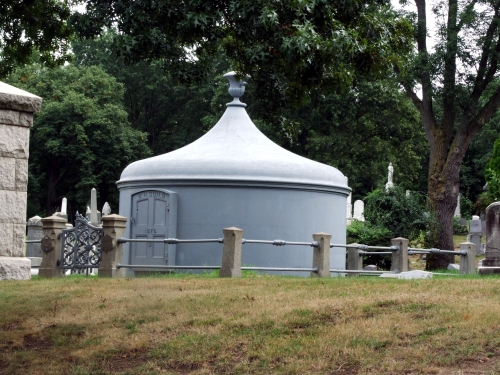
The Cemetery of the Evergreens on the border of Brooklyn and Queens doesn’t have the same fame as Brooklyn’s larger Green-Wood Cemetery, but the concept behind both facilities was the same: to bury the dead in a park on high ground, surrounded by natural beauty; a place where people could get away from the city streets and spend time with departed loved ones in the most beautiful settings possible. Both cemeteries were part of an American trend towards naturalistic, park-like cemeteries, an idea borrowed from England and brought to the United States in 1831. Green-Wood Cemetery was founded in 1838, and in 1849, the Cemetery of the Evergreens opened its gates to receive its first permanent residents. The first part of our story has many more details on the design of the cemetery.
Today we regard death much differently than the early Victorians who built these cemeteries. Life was hard for most people, life expectancies were much shorter in general, and for rich and poor alike, death could easily come from childbirth, disease, accident or war. Unlike today, where modern medicine and better living conditions have pushed death as far away as possible, the Victorians embraced it as a part of life. Funerals generally took place in the home, and burial in a beautiful park where one could visit, and even make a day of it, proved extremely popular.
Green-Wood and Evergreens have much in common. Both are built on the same terminal moraine; high ground left by the progress of the glaciers millennia ago. Both sites also played a much later role in the Revolutionary War. The first great battle of that war was fought in Brooklyn in 1776, when the British and their Hessian allies landed at Gravesend Bay and pushed forward to Flatbush, intending to defeat George Washington’s newly formed American army, and put a quick end to the American rebellion.
As the British troops progressed through Brooklyn, the army of over 10,000 men stretched for miles. When they reached New Lots, they forced William Howard and his son, local tavern keepers, to lead them on the old Rockaway Footpath, an Indian trail that today runs directly through the Cemetery of the Evergreens. The British marched to the town of Bedford and then on to Gowanus, where the bloody battle between the forces took place. This includes the high ground, now part of Green-Wood Cemetery. Both cemetery sites are important memorials to the first major battle in the war of American independence.
One can certainly see why this Rockaway trail would be important to both the native people who created it and later colonists. The view from the top of the cemetery is impressive. Situated almost in the center of Brooklyn, one can see the towers of Manhattan rising on one side and the lowlands of East New York going towards Gravesend Bay in the other, both much farther away than they look. What a change in only two hundred years, from wilderness and small towns to an entire view now of a city of millions of people and thousands of buildings.
When Andrew Jackson Dowling and Alexander Jackson Davis laid out the Cemetery of the Evergreens, they did so with the intention of maximizing the park-like features of the natural rolling hills and that great view. The entrance to the cemetery on Bushwick Avenue leads a visitor up the hill on a winding road that leads to the chapel at the highest point on the hill. It’s a beautiful Gothic Revival country church, which was designed by Davis. A few years after the chapel was built, he also designed the rustic shelter across the street, called the Summer House. It was designed to be a gathering place for mourners.
And who were those who came to mourn? Evergreens is non-sectarian, not dedicated to any one denomination, faith or following. A look at the older and more impressive monuments shows that the cemetery was very much used by a wealthy German-American population in the latter part of the 19th century. Most of the names on the rows of mausoleums are German, as are many of the largest monuments, some with German inscriptions. There are brewmeisters, industrialists and ministers, as well as ordinary folk. Interestingly enough, many seemed to order the same monument, a tall obelisk on a pedestal with Neo-Grec patterns. It shows up a lot in the German part of the cemetery. It would be interesting to see if there’s a story there.
There is now a very large Chinese section of the cemetery, dating from the last half of the 20th century into the present. And of course, there are the famous and infamous buried here. Some of Evergreen’s more notable residents include cartoonist Walt Kelly, jazz saxophonist Lester Young, Amy Vanderbilt (the manners columnist), entertainer Bill “Bojangles” Robinson and actor William Hickey, as well as several early major league baseball players, several chess champions, late 19th- and early 20th-century actors and entertainers, and artists.
Two more recent residents, who made the news in the last twenty years, are murder victim Yusef Hawkins, who was killed while walking through Bensonhurst, and City Councilman James E. Davis, who was murdered in the City Council Chambers. He was originally interred in Green-Wood Cemetery, but when it was discovered that his murderer was also buried there, his body was brought to Evergreens. His monument is right on the main road to the chapel.
The cemetery also is the final resting place for some of the people in the worst tragedies in New York City’s history. Eight of the victims of the Triangle Shirtwaist Factory disaster are buried here, interred under a large monument. It was only recently that researchers were able to identify the bodies and give names to six of the victims.
Also buried here are victims of the Brooklyn Theater fire of 1876, in which over 200 people lost their lives. Over two dozen of the named victims are here in various parts of the cemetery. The Walkabout story of this horrific fire can be found here and here. In 1904, a large group of German-American church-goers from the Lower East Side crowded on the General Slocum ferry in Manhattan to enjoy an outing to Long Island. The boat caught fire in the harbor, and the resulting conflagration would kill over 1,000 people, most of whom were drowned, trampled or burned to death. The dead were buried all over New York City, with over fifty interred in Evergreens, all identified and individually buried by their families.
The cemetery of the Evergreens has a large section of plots reserved by the New York Actors’ Guild. Bill Robinson and others are buried there. Actors and entertainers were not always as highly admired as they are today; in fact, in the Middle Ages in Europe, they could not be buried in sacred ground. It was important for the Guild to be able to have plots available, especially for those in the profession who were not household names, ensuring that these people could rest in peace with their peers in a place where they were welcomed.
Also welcomed were sailors who died in New York City. The grassy knoll at the front near the Bushwick entrance has markers showing the countries where these sailors originally hailed from. There are markers noting lands all over the world. There are Civil War veterans, all but one from the Union side, buried across the cemetery. This includes two Medal of Honor recipients. Included among the Civil War dead are members of New York’s 20th Regiment, an all-black regiment, one of the segregated units of United States Colored Troops that marched into war in 1864. Many are buried in the plot belonging to the Frederick Douglass G.A.R. Post, the veterans of the Grand Army of the Republic.
The Cemetery of the Evergreens is not as crowded as Green-Wood. Most of the sections, even in the oldest parts, do not have the headstones packed next to each other as tightly as in some parts of Green-Wood. Personally, I like old cemeteries. As they were designed to be, I find them beautiful, peaceful and artistic. The artistry of the stone carvers can be just amazing, with some real works of art in place. Many of the mausoleums have beautiful stained glass panels visible through the gates, and many of those gates are impressive examples of metalwork and sculpture. The landscaping is beautiful, and while Green-Wood is certainly more impressive, with lakes and more hills, Evergreen allows you to see the man-made play of horticulture and environment with a bit more perspective, keeping with the idea of a park. I highly recommend a trip, to see for yourself. GMAP
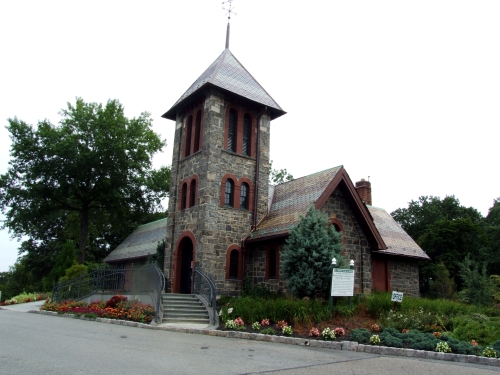
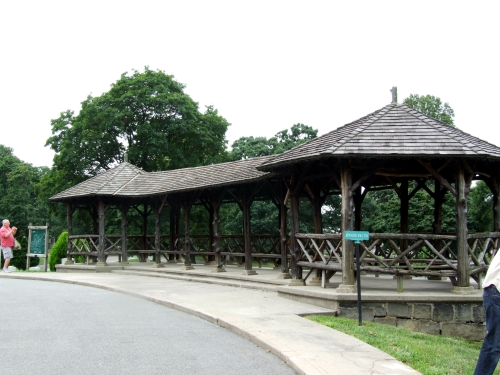
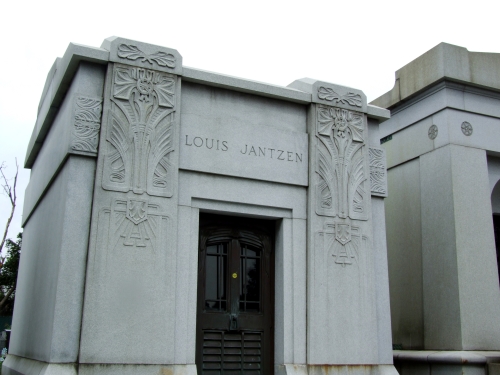
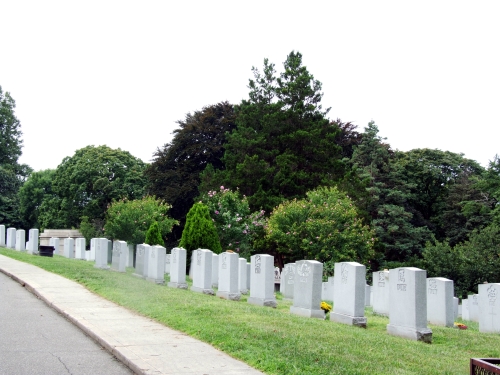

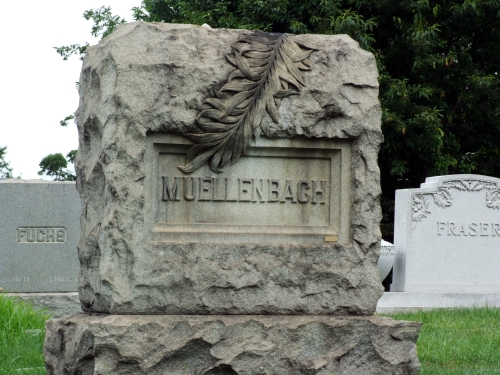
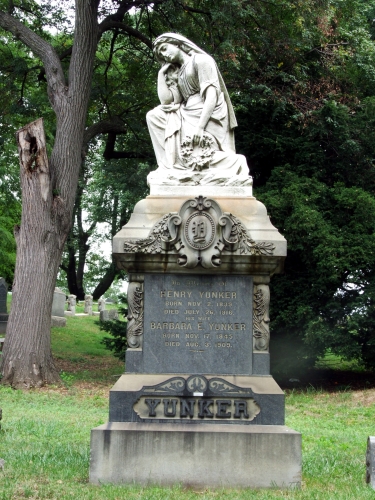




And I thought it was of the founder of Hershey’s Chocolate!